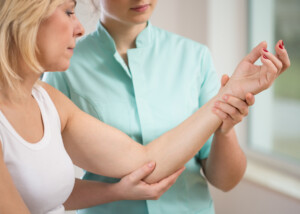
If you’ve been noticing lately that your fingers are becoming crooked, you’ll actually wish that this was only carpal tunnel syndrome.
Because what it most likely is – is far less treatable than carpal tunnel syndrome.
Carpal Tunnel Syndrome and Crooked Fingers
“Carpal tunnel syndrome causes absolutely no mechanical deformities,” begins Alejandro Badia, MD, FACS, hand and upper limb surgeon and owner of Badia Hand to Shoulder Center in Doral, FL., and founder of OrthoNOW, the only urgent orthopedic care franchise in the world.
“It has nothing to do with it; it [CTS] is a metabolic hormonal phenomenon which is due to basically fluid shifts and changes in the ground substance of the lubricating lining of the tendons,” explains Dr. Badia.
“When the tendons are thickened it causes secondary compression of the nerves.” This compression does not affect the positioning of the bones in your fingers.
Instead, the compression upon the median nerve results in the classic symptoms of carpal tunnel syndrome: numbness, tingling and/or pain.
The fingers, however, will remain perfectly straight unless some other, unrelated cause, swoops in and starts making the fingers crooked.
Dr. Badia says that CTS “is not a primary nerve problem; one of the reasons it’s called a syndrome. It is a constellation of symptoms.
“It does not cause crooked fingers, and I will tell you that that is usually due to osteoarthritis, particularly osteoarthritis at the base of the thumb, basal joint arthritis.”
Osteoarthritis in the fingers is far less treatable than carpal tunnel syndrome.
Osteoarthritis is a wearing down of the cartilage between bones.
If the cartilage wears down enough, it will cause painful bone on bone contact. There is no treatment that restores the cartilage.
Another cause of crooked fingers is rheumatoid arthritis – completely unrelated to carpal tunnel syndrome.
There are other conditions, unrelated to CTS, that cause wayward fingers.
Dr. Badia points out, however, that in those with osteoarthritis of their hand, there is a higher incidence of carpal tunnel syndrome because the arthritis “changes the dimensions of the CTS.”










































